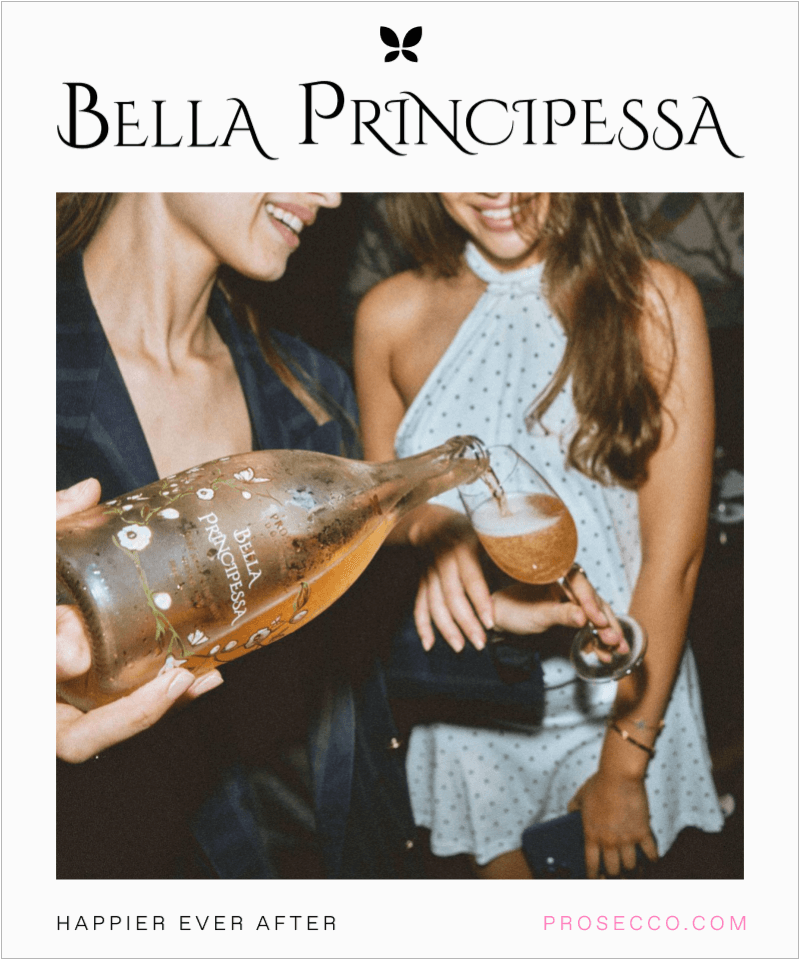The question, “Is Prosecco a Rosé Wine or Champagne?” underscores a common curiosity in sparkling wines, a domain where terminology and production methods are crucial in defining each category.
Understanding the distinction between Prosecco, Rosé Prosecco, and Champagne is essential for appreciating the diversity and uniqueness of these effervescent beverages, including popular brands like Bella Principessa Prosecco and Signorina Prosecco.
Prosecco: A Distinct Italian Sparkling Wine
Prosecco, originating from the Veneto region in Northern Italy, is a sparkling white wine predominantly made from the Glera grape variety. It is uniquely positioned in the sparkling wine world, known for its light, fruity, and approachable character.
The production of Prosecco involves the Charmat method, where the secondary fermentation, responsible for creating the bubbles, occurs in large steel tanks. This method is one of the critical factors distinguishing Prosecco from Champagne in terms of flavor and cost.
Notably, Prosecco is neither a rosé wine nor Champagne but a sparkling wine category of its own, with brands like Bella Principessa Prosecco exemplifying the quintessential Prosecco style.
Rosé Prosecco: A Variation with a Rosé Twist
Rosé Prosecco, a relatively recent addition to the Prosecco family, is a pink sparkling wine. It is made by adding a small amount of red wine to the Prosecco blend, often resulting in a slightly sweeter taste profile than traditional Prosecco.
This variant provides a rosé experience within the Prosecco category, offering a different palette of flavors while maintaining the refreshing and effervescent qualities of classic Prosecco. It’s important to note that Rosé Prosecco is a distinct style within the Prosecco category and not a separate wine type like traditional rosé wines, which are typically still and made solely from red grapes.
Champagne: The Epitome of Traditional Sparkling Wine
In contrast, Champagne is a prestigious sparkling wine from the Champagne region of France. It is renowned for its traditional production method, the “méthode champenoise,” where the secondary fermentation occurs in the bottle.
This time-intensive and laborious process contributes to Champagne’s complexity, depth of flavor, and higher price point. Champagne can be made from Chardonnay, Pinot Noir, and Pinot Meunier grapes and can be white or rosé in color.
Unlike Prosecco, Champagne’s designation is strictly protected, meaning only sparkling wines produced in the Champagne region using the specified methods can be labeled as Champagne. This exclusivity sets brands like Champagne apart from sparkling wines like Bella Principessa Prosecco and Signorina Prosecco.
Comparative Overview: Prosecco vs. Rosé Prosecco vs. Champagne
- Origin & Grape Varieties:
- Prosecco: From Veneto, Italy; predominantly Glera grapes.
- Rosé Prosecco: A variation of Prosecco with added red wine for color.
- Champagne: From Champagne, France; typically Chardonnay, Pinot Noir, Pinot Meunier grapes.
- Production Methods:
- Prosecco: Charmat method (secondary fermentation in tanks).
- Rosé Prosecco: Similar to Prosecco with the addition of red wine.
- Champagne: Méthode champenoise (secondary fermentation in the bottle).
- Flavor Profiles:
- Prosecco: Light, fruity, often with apple and pear notes.
- Rosé Prosecco: Slightly sweeter with a hint of berries.
- Champagne: Broad range, from crisp and citrusy to rich and toasty.
- Price Point:
- Prosecco: Generally more affordable, including brands like Bella Principessa Prosecco.
- Rosé Prosecco: Comparable to Prosecco, offering a rosé experience at a similar price.
- Champagne: Typically more expensive, reflecting its traditional production method.
Conclusion: Celebrating Diversity in Sparkling Wines
In conclusion, Prosecco, including variations like Rosé Prosecco and Champagne, represents different experiences within the sparkling wine spectrum.
With its refreshing and approachable character, Prosecco and brands like Bella Principessa Prosecco offer a delightful sparkling wine experience distinct from the traditional and prestigious Champagne.
Bella Principessa’s Rosé Prosecco adds another dimension to this diversity, combining the charm of Prosecco with a touch of rosé elegance. Understanding these differences enriches the appreciation of sparkling wines, whether enjoying a glass of Signorina Prosecco or toasting with Champagne.











